Recent Posts
Safety Tips for Smoke Alarms
12/2/2024 (Permalink)
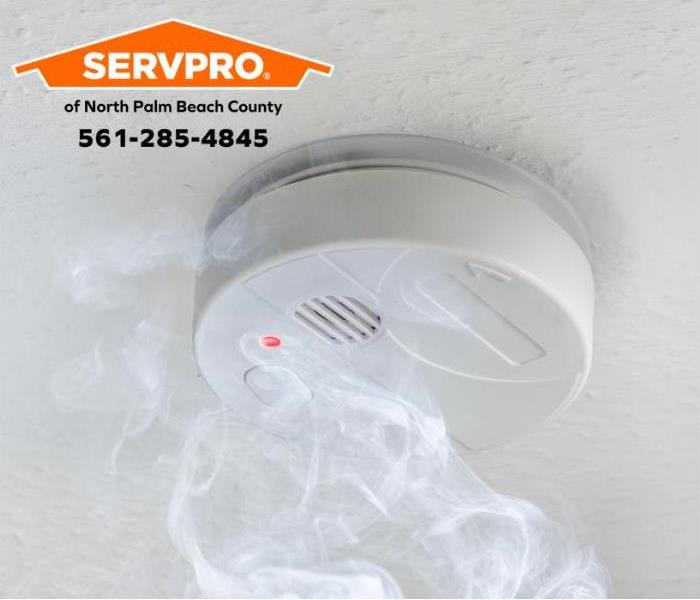 We respond to fire damage emergencies 24-hours a day.
We respond to fire damage emergencies 24-hours a day.
Smoke alarms are a key part of a home fire escape plan. When there is a fire, smoke spreads fast. Working smoke alarms give you early warning so you can get outside quickly. Here are some helpful tips from the National Fire Protection Association (NFPA) about smoke alarms:
SAFETY TIPS
- Install smoke alarms in every bedroom. They should also be outside each sleeping area and on every level of the home. Install alarms in the basement.
- Large homes may need extra smoke alarms.
- It is best to use interconnected smoke alarms. When one smoke alarm sounds, they all sound.
- Test all smoke alarms at least once a month. Press the test button to be sure the alarm is working.
- Current alarms on the market employ different types of technology including multi-sensing, which could include smoke and carbon monoxide combined.
- A smoke alarm should be on the ceiling or high on a wall. Keep smoke alarms away from the kitchen to reduce false alarms. They should be at least 10 feet (3 meters) from the stove.
- Replace all smoke alarms when they are 10 years old.
Call Us Today!
When your home or commercial business needs fire restoration services, SERVPRO of North Palm Beach County has a team of highly trained technicians on-call and ready to respond 24-hours a day.
SERVPRO Offers Reconstruction Services
10/31/2024 (Permalink)
 SERVPRO of North Palm Beach County offers reconstruction services.
SERVPRO of North Palm Beach County offers reconstruction services.
In addition to water mitigation, fire cleanup, and mold remediation, SERVPRO of North Palm Beach County also offers reconstruction services. After our professionals are done with drying out a property or removing smoke-damaged materials, we can put your home or business back together just like the way it was before the damage occurred.
Here are just some of the reconstruction services SERVPRO of North Palm Beach County offers:
- Drywall repair and installation
- Baseboards
- Floor repair and replacement
- Kitchen and bath installation and remodeling
- Cabinet and trim replacement
- Insulation installation
- Ceiling repair
- Fixture replacement
- Painting
The convenience and savings of working with one company to assist with mitigation and repairs can be significant. We are a one-stop shop for all of your construction needs. SERVPRO of North Palm Beach County has experienced professionals that believe in delivering quality workmanship. Please contact us at 561-285-4845.
Choose SERVPRO for Commercial Property Damage Restoration Services in North Palm Beach County
4/25/2024 (Permalink)
 We provide commercial property damage services 24-hours a day.
We provide commercial property damage services 24-hours a day.
Our SERVPRO of North Palm Beach County teams are trusted leaders in commercial property damage restoration services. We know that every minute counts when your business is compromised by property damage. Our technicians are on call and ready to respond to your emergency 24 hours a day.
Our technicians are trained and certified by the Institute of Inspection Cleaning and Restoration Certification (IICRC) to provide a full range of services to get your commercial business operational again quickly after a property damage loss.
SERVPRO Offers
- 24 Hour Emergency Service
- Faster to Any-Sized Disaster
- Highly Trained Technicians
- A Trusted Leader in the Restoration Industry
- Locally Owned and Operated
- Advanced Restoration and Cleaning Equipment
Commercial Restoration Services
- Water Damage Restoration
- Fire Damage Restoration
- Mold Remediation
- Storm Damage Cleanup
- Commercial Construction Services
Commercial Cleaning Services
- Air Ducts & HVAC
- Biohazard
- Carpet and Upholstery
- Ceiling, Walls, and Hard Floors
- Drapes and Blinds
- Odor Removal and Deodorization
- Sewage and Toilet Overflow
- Trauma and Crime Scene
- Vandalism and Graffiti
Call Us Today!
When your commercial business needs property damage restoration services, SERVPRO of North Palm Beach County is ready. Call us today at 561-285-4845.
Fire Damage in North Palm Beach County, Call SERVPRO
2/22/2024 (Permalink)
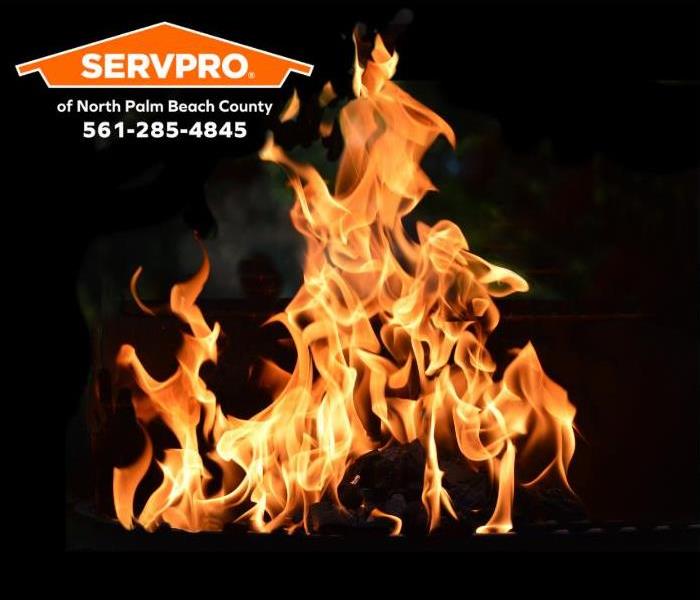 We respond to fire damage emergencies 24-hours a day.
We respond to fire damage emergencies 24-hours a day.
Even small fires will cause smoke and soot damage to other areas of the house. The professionals at SERVPRO of North Palm Beach County are trained and certified to clean and restore fire damage quickly and efficiently. Here are some tips from our website on things you can do while waiting for help to arrive:What To Do After A Fire• Limit movement in the home to prevent soot particles from being embedded into upholstery and carpets.• Keep hands clean so as not to further soil upholstery, walls, and woodwork• Place clean towels or old linens on rugs, upholstery, and carpet traffic areas• If electricity is off, empty freezer and refrigerator and prop doors open• Clean and protect chrome with a light coating of petroleum jelly or oil• Wash houseplants on both sides of leaves• Change HVAC filter• Tape double layers of cheesecloth over air registersWhat NOT To Do After A Fire• Don't attempt to wash any walls or painted surfaces or shampoo carpet or upholstery without contacting us• Don't attempt to clean any electrical appliances that may have been close to fire, heat, or water without consulting an authorized repair service• Don't use any canned or packaged food or beverages that may have been stored near the fire, heat, or water• Don't turn on ceiling fixtures if the ceiling is wet. The wiring may be damaged.• Don't send garments to an ordinary dry cleaner. Improper cleaning may set smoke odor.Call Us Today!When your home or commercial business has fire, smoke, and soot damage, SERVPRO of North Palm Beach County is available to help. Call us today at 561-285-4845.
Water Damage Restoration for your Business
1/22/2024 (Permalink)
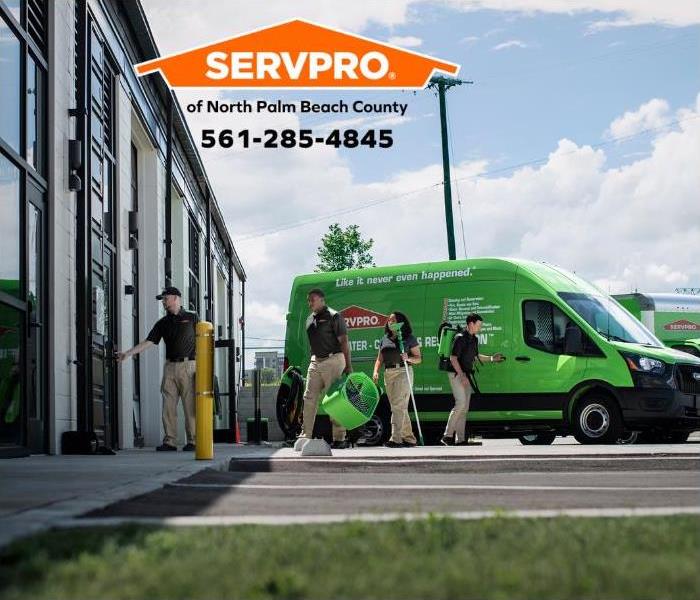 SERVPRO of North Palm Beach County will respond to your water damage emergency.
SERVPRO of North Palm Beach County will respond to your water damage emergency.
Water damage to your industrial or commercial property can be particularly devastating. Not only is there the damage itself that needs to be repaired quickly, but there’s the disruption of your service to customers and employees.
SERVPRO of North Palm Beach County professionals are prepared to evaluate your water-damaged property. We want to help you understand the severity of the water damage to your commercial property so that you’re able to make the best decisions on moving forward with the restoration process. Whether you’re dealing with minor water damage to your commercial property or a large-loss event, we can develop a restoration plan to help ensure your property is clean, dry and restored to its pre-damaged condition.
Our team of professionals will assess the water damage to your property. Then we’ll help you understand the severity of the damage so you’re able to make the best decisions for the restoration of your business. We use only the most advanced equipment to detect hidden moisture and extract standing water.
If your business experiences a water damage emergency, you can count on SERVPRO of North Palm Beach County to respond 24-hours a day, call us at 561-285-4845.
Keep Your Business Running
11/29/2023 (Permalink)
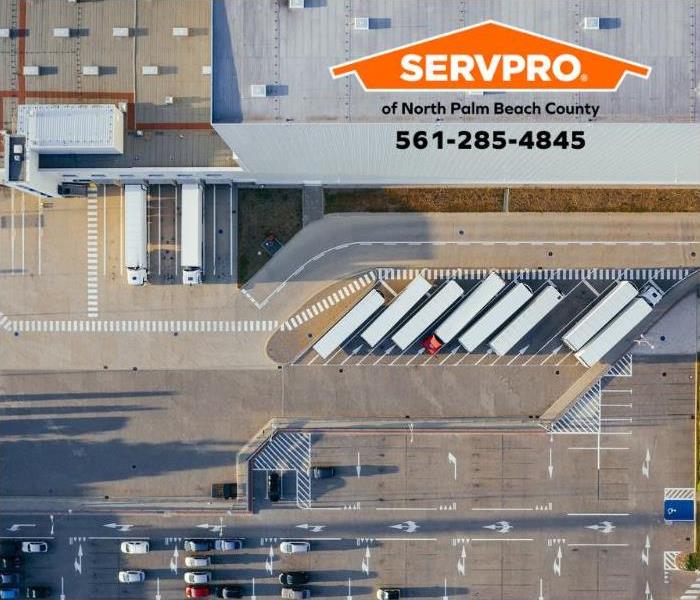 SERVPRO of North Palm Beach County provides several commercial restoration services.
SERVPRO of North Palm Beach County provides several commercial restoration services.
SERVPRO of North Palm Beach County understands the need to keep your business operational, even after an emergency. If your business experiences a fire, water leak, or a mold problem, we are available to help. We offer flexible solutions and work after hours or around the clock to complete your restoration project. Our highly trained professionals will respond quickly and provide the expertise to get the job done right.
We offer the following Commercial Services:
- Fire, Smoke and Soot Cleanup and Restoration
- Water Removal and Dehumidification
- Crime Scene, Biohazard and Vandalism Cleanup
- Mold Mitigation and Remediation
- Air Duct and HVAC Cleaning
- Carpet and Hard Floor Cleaning and Care
- Stain Removal, Stain Resistance Applications
- Odor Identification and Deodorization
- Upholstery and Drapes Cleaning
As a trusted leader in the restoration industry, SERVPRO of North Palm Beach County has highly trained technicians that are dedicated to responding Faster to any size disaster™. We provide 24-hour emergency service and have the training and expertise to handle your restoration and cleaning needs. Please contact us at 561-285-4845.
Heavy Rains can cause Flash Flooding
8/24/2023 (Permalink)
 We respond to storm damage emergencies 24-hours a day.
We respond to storm damage emergencies 24-hours a day.
Florida has experienced some severe weather events that have caused significant damage to homes and commercial properties in our area. SERVPRO of North Palm Beach County is trained and certified to restore storm damage by the Institute of Inspection Cleaning and Restoration Certification (IICRC). Heavy rains can cause flash flooding, so it is a good idea to know what to do when faced with a flash flood situation. Here are some flash flood safety tips from the National Weather Service:
- During periods of heavy rains, stay away from flood-prone areas such as stream beds, drainage ditches, and culverts
- Move to higher ground if flooding threatens your area
- If you live or work in flood-prone areas, remain alert during periods of heavy rain
- Be especially cautious at night as it is harder to recognize flood dangers
- Never drive your car into water of unknown depth. Most flash flood deaths occur when people drive their vehicles into flood waters. Remember: Turn Around Don’t Drown!
- If your vehicle stalls, abandon it immediately and seek higher ground. Flood water may rise quickly, cover the vehicle, and sweep it away.
- Stay out of flooded areas. The water may still be rising and very swift. A rapidly flowing stream can sweep you off your feet and sweep your vehicle downstream.
Call Us Today!
If your home or commercial business has experienced flooding damage, SERVPRO of North Palm Beach County will restore the damage “Like it never even happened.” Call us today at 561-285-4845.
SERVPRO can Help with a Chemical Spill
8/1/2023 (Permalink)
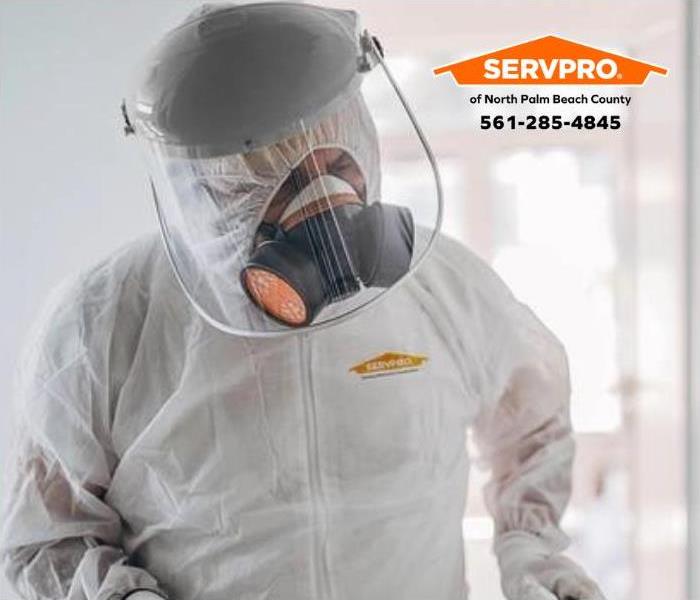 We respond to chemical and biohazard emergencies 24-hours a day.
We respond to chemical and biohazard emergencies 24-hours a day.
SERVPRO of North Palm Beach County is trained and certified to clean and restore chemical spills and biohazards. North Palm Beach residents and businesses can rely on us to arrive quickly and immediately begin the cleanup process.
Along with the cleanup and safe removal of chemical spills, we offer a full range of biohazard cleaning services, including:
- Chemical spills
- Sewage backups
- Crime scene residues
- Suicide/death accidents
- Homicide cleanups
- Blood cleanup
- Accident cleanup
- Hoarding scenes
- Animal waste/remains
- Tear gas cleanup
The safe decontamination of a home or business after any form of chemical or biohazard exposure is critical. Our technicians are trained and certified to mitigate these kinds of dangerous situations. Here are some tips from our website on what to do after a contamination:
What to Do After a Contamination
- Stay out of affected areas
- Call emergency service personnel if the situation is life-threatening
- Treat all bodily fluids as if they are contaminated
- Turn off the heating, ventilation, and air conditioning (HVAC) system if there is sewage damage
Call Us Today!
When you need help cleaning up a chemical spill, SERVPRO of North Palm Beach County is available to help. Our technicians are on-call 24-hours a day to respond to chemical and biohazard damage emergencies.
Safety Tips for Patio Heaters
7/26/2023 (Permalink)
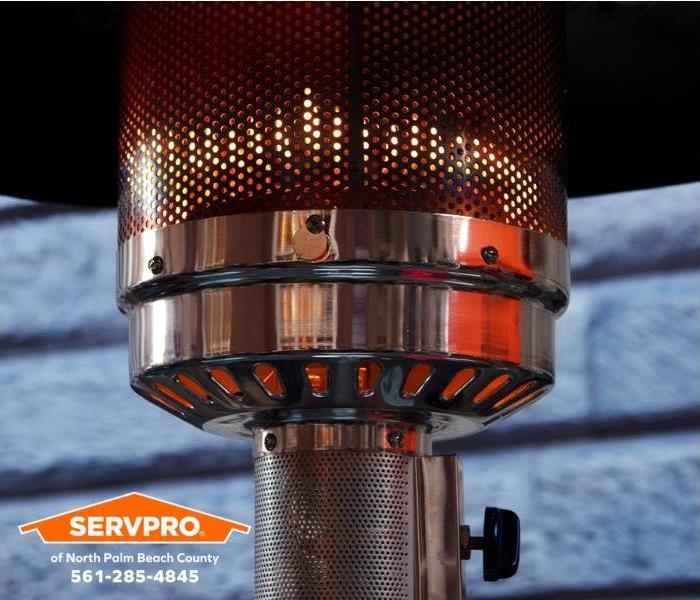 We respond to fire damage emergencies 24-hours a day.
We respond to fire damage emergencies 24-hours a day.
SERVPRO of North Palm Beach County responds to commercial fire damage emergencies throughout the year. More businesses are using propane heaters to keep customers and employees warm on chilly days and nights. Here is some information from the National Fire Protection Association for using outdoor propane heaters safely:
Propane Patio Heaters
For patio heaters that use integral LP-Gas containers with a capacity greater than 1.08 lb. (0.49 kg), NFPA 1 requires that the heaters be listed by an organization acceptable to the authority having jurisdiction (AHJ).
Propane heaters need to be used in accordance with their listing and manufacturer instructions. Prior to using a propane heater, refer to the manufacturer’s instructions for information such as the following:
- Necessary clearances from the heating element
- Proper ventilation required
- Proper inspection, cleaning, and maintenance procedures
- Lighting and shutdown procedures
- Where the heater can and cannot be used (for example, heaters cannot be used in enclosed locations)
- Procedures for properly storing heaters
The restrictions for using propane heaters are also based on the occupancy in which they are used. For example, in assembly occupancies, such as restaurants with 50 or more occupants, heaters cannot be located within 5 ft (1.5 m) of the exits. Regardless of where they are used, if a heater uses propane hoses, they must be as short as possible, visible, and protected from damage.
Call Us Today!
When your North Palm Beach home or commercial business needs fire damage restoration services, SERVPRO of North Palm Beach County is Here to Help. ® Call us today at 561-285-4845.
Mold Remediation Process - SERVPRO
2/23/2023 (Permalink)
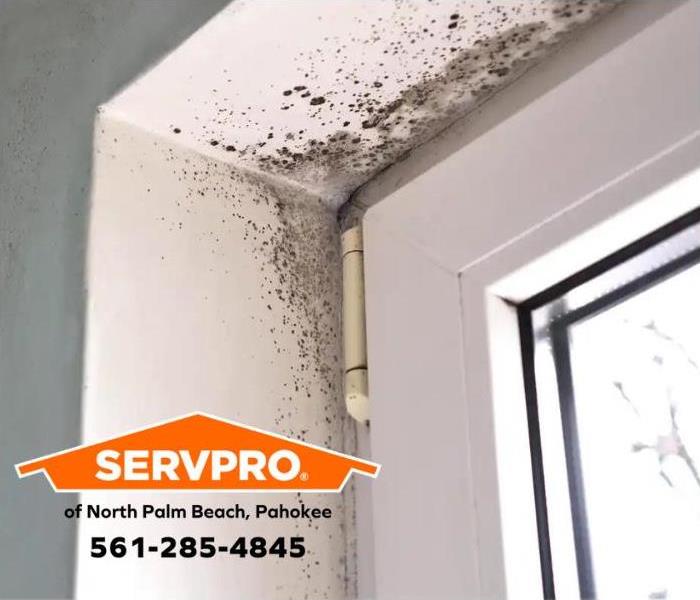 When you discover mold, SERVPRO of North Palm Beach, Pahokee can help!
When you discover mold, SERVPRO of North Palm Beach, Pahokee can help!
When you discover mold growing in your West Palm Beach home or commercial business, fast action is required to mitigate the damage before the mold can spread to other areas in the home or workplace. SERVPRO of North Palm Beach, Pahokee can mitigate the mold damage and the mold remediation process usually follows the steps below:
Inspection and Mold Damage Assessment
Identifying and addressing the source of the moisture that is causing the mold growth. This step usually involves the use of various technologies to detect mold growth and water sources that may be hidden. We follow local and state laws regarding inspection and documentation based on your unique situation.
Mold Containment
We may use advanced containment procedures like negative air chambers to isolate the contaminated area with physical barriers and negative air pressure to prevent mold spores from spreading during the cleanup process.
Air Filtration
We utilize powerful “air scrubbers” and HEPA vacuums to prevent the spread of these mold spores while mold remediation is in process.
Removing Mold and Mold-Infested Materials
We use antifungal and antimicrobial treatments to eliminate mold colonies and to help prevent new colonies from forming. We remove and dispose of mold-infested porous materials when remediating heavy mold growth.
Cleaning Contents
We clean your furniture, decorative items, curtains, and other restorable items affected by mold. We also remove odors and deodorization using fogging equipment.
Restoration
Restoration may involve minor repairs, such as replacing drywall, painting, and installing new carpet, or it may require the reconstruction of various areas or rooms in a home or business.
Call Us Today!
If your home or business has a mold problem, we can inspect and assess your property and use our specialized training, equipment, and expertise to remediate your mold infestation. Call us today at 561-285-4845.

 24/7 Emergency Service
24/7 Emergency Service









